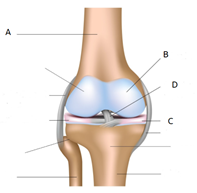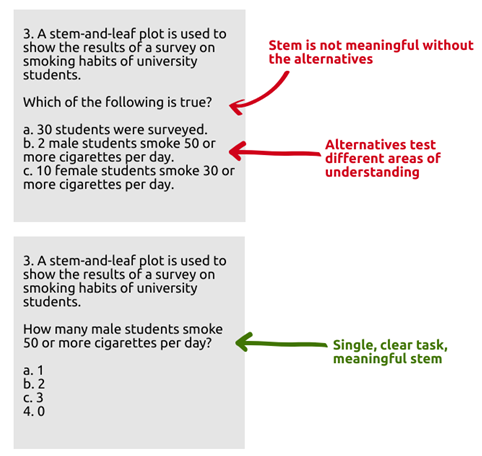Writing Good Questions
Definition
While traditional forms of assessment, such as quizzes, tests, and exams are not the only way to assess student learning, they can be the most practical way to do so. However, questions on these types of assessments need to be carefully created so they are fair, clear, and challenging enough for your students.
Explanation
Quizzes, tests, and exams can all be delivered in different ways and can be used to test different areas of knowledge and skill, depending on the question types and how they are written. Understanding the types of questions and the types or levels of learning is essential to creating good test questions.
It is important to understand the purpose of the question first, before selecting the type of question (e.g., essay, multiple choice).
-
Objective Questions
Questions where students choose the correct response from a group of answers, or complete a question or statement with a word or phrase. Question formats that are typically objective are
- Multiple choice
- True/false
- Matching
- Fill-in-the-blank
In Canvas, you can choose the correct response(s) and use the system to automatically grade these types of questions.
Examples
From the diagram, identify the patella.

Example of an objective question for human anatomy.
What is the chemical formula for sulfuric acid?
- HS
- H2SO4
- H2SO3
- H2S3
Example of an objective question for chemistry.
Who is considered ‘the father’ of modern psychology?
- Sigmund Freud
- Jean Piaget
- Wilhelm Wundt
- PF Skinner
Example of an objective question for psychology.
-
Subjective Questions
Students must create an original response to the question. Question formats that are typically subjective are
- Essay
- Short answer
- Problem solving
- Calculations
In Canvas, these types of questions require reading and grading by an instructor or TA.
It is also important that your questions be created so that you can assess if a learning objective has been met. If you are mainly concerned with recall of facts with a high degree of accuracy, you may want to use primarily objective questions. However, if you want students to synthesize many areas of knowledge into a cohesive response, you may use primarily subjective questions. Align the type or types of questions you use with the goal of the assessment.
Use a combination of objective and subjective questions to test a full range of cognitive complexity.
Objective questions are useful for testing lower-order thinking, such as recall or understanding. They are less useful for higher order thinking, such as analysis or application. Subjective questions often require students to connect multiple concepts together and are best used for higher order thinking, such as analysis, evaluation, or creation. Instructors tend to use lower order questions, in the knowledge category, up to 90% of the time. While they aren’t bad questions on their own, relying solely on them doesn’t help you or your students achieve their learning goals.
Application
-
1. Understand which of your learning objectives you wish to test
It is important that the overall assessment be aligned with learning objectives of the course, or else you (and your students) will be answering meaningless questions.
You will likely want to assess a variety of learning objectives in a single assessment. However, do not test with questions that have not been covered in the course, or those students “should” know from other courses. -
2. Determine the goals of the question
Do you want to test students’ recall of important chemical formulas or do you want them to demonstrate how they can apply this knowledge to generate a desired product? Each of these are worthwhile assessment goals, but require different types of questions to be assessed properly.
-
3. Choose questions for appropriate cognitive complexity
Look at the other questions and their goals. Are you choosing questions that are primarily recall in nature, or are they requiring students to use critical thinking to decide on a response? It is beneficial to have a variety of question types and complexities.
-
4. Choose the question type
Once you have determined the type of question (objective vs subjective) and the level of complexity of the question, select the question format.
-
5. Choose the question format
The question stem (the question itself) should present a clear, single task that can be understood on its own, without the need for additional context (e.g., the alternatives or distractors of the question).
Write the question stem in simple, clear language. Avoid adding unnecessary or non-functional material that tests students’ reading comprehension rather than understanding of the material.Questions should be free of bias from gender, race, sex, or orientation.
Any alternatives (incorrect response choices) should be distinct, clear, and plausible. Avoid “trick” questions, where the correct response and alternatives are very close to one another or require students to decipher implications from the question stem.
-
6. Ensure the answer is clear
Have a colleague or TA check the question to ensure it is clear and understandable, but also that the correct answer is marked correctly. Proofread your questions as well.
If you are using a marking key for longer subjective questions, make sure that others can clearly understand how marks should be allocated.
Example

